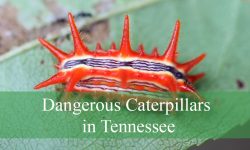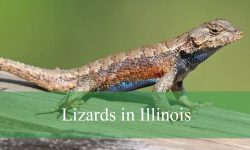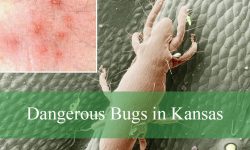Colorado is home to a wide variety of spiders, most of which are harmless. However, a few species can pose serious health risks if bitten. Knowing how to identify these spiders is crucial for safety, especially in homes, gardens, and outdoor areas.
From the infamous Western Black Widow to the reclusive Brown Recluse, this state hosts several species with venomous bites that can cause pain, swelling, or more severe symptoms. Awareness and proper precautions are essential to avoid accidental encounters.
This guide covers the five most dangerous spiders in Colorado, detailing their appearance, behavior, habitats, and bite risks. With pictures and identification tips, you’ll learn how to stay safe while observing or sharing space with these fascinating arachnids.
Types of Dangerous Spiders Found in Colorado
Western Black Widow (Latrodectus hesperus)
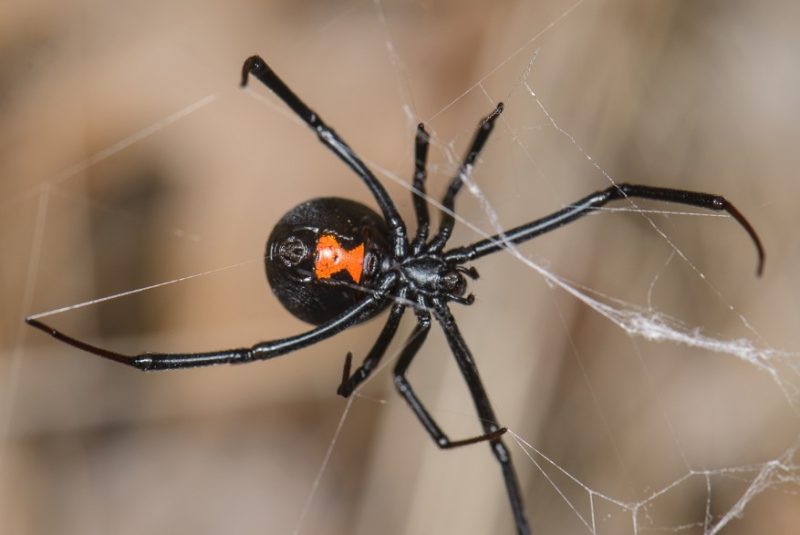
Appearance and Identification
The Western Black Widow has a glossy black or dark brown body, typically 6.4–8.5 mm in length for females. Its most distinctive feature is the red hourglass marking on the underside of the abdomen, although the shape and color intensity can vary. Males are smaller, often brown or gray, with faint red or white markings and lack the prominent hourglass. Juveniles can have yellow or orange striping on the back.
Size
Adult females measure about 6.4–8.5 mm, while males are smaller at roughly 3–4 mm. Despite their small size, their long legs and shiny black color make them relatively noticeable in dark areas. The abdomen is spherical, contrasting with the slender legs.
Behavior
Black widows are solitary and non-aggressive, generally biting only when provoked or trapped. They construct irregular, tangled webs in dark, undisturbed corners, such as garages, woodpiles, and basements. They often hang upside down in the center of the web to ambush prey like insects.
Bite and Venom
A bite can cause severe muscle cramps, abdominal pain, nausea, and in rare cases, difficulty breathing. Their venom is a neurotoxin that disrupts nerve signaling, affecting both humans and small prey. While rarely fatal to healthy adults, bites can be serious for children, the elderly, or those with compromised immune systems.
Habitat and Distribution
Western Black Widows are common throughout the western United States, from British Columbia and Washington to Arizona and Texas. They prefer dark, sheltered areas and are often found around human structures where they can remain undisturbed. They thrive in temperate climates but can adapt to arid environments.
Brown Recluse (Loxosceles reclusa)
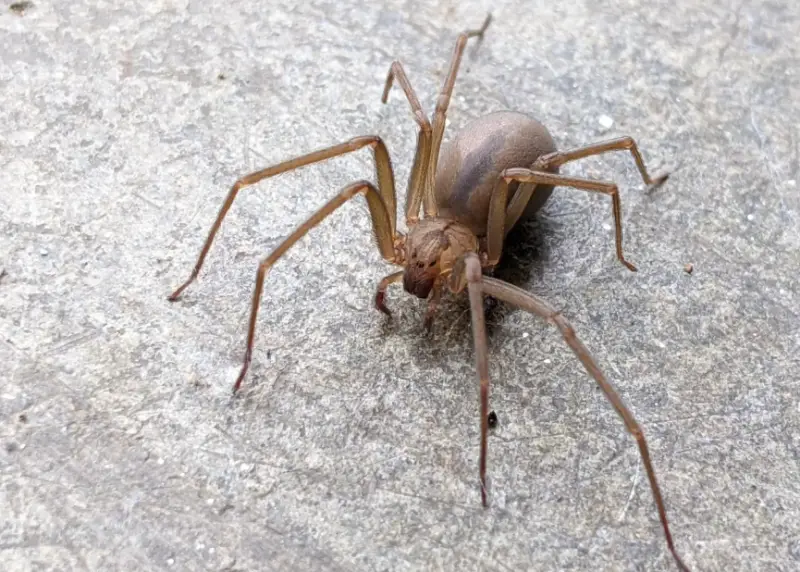
Appearance and Identification
Brown Recluses are light to medium brown with a darker violin-shaped marking on the dorsal side of the cephalothorax, pointing toward the abdomen. Their legs are long, thin, and uniformly colored without bands. The eyes are arranged in three pairs in a semicircle, which helps distinguish them from other spiders with six or eight eyes.
Size
Adult Brown Recluses measure 6–20 mm in body length. Females are generally slightly larger than males. Despite their modest size, their elongated legs and characteristic violin marking make them identifiable to experienced observers.
Behavior
These spiders are reclusive, preferring to hide in dark, undisturbed areas like closets, attics, basements, or under furniture. They are nocturnal hunters, feeding on insects at night and retreating to their secluded hiding spots during the day. They are non-aggressive and bite only when pressed against the skin.
Bite and Venom
The bite may go unnoticed initially but can cause necrotic lesions, blistering, and slow-healing ulcers over days to weeks. Their venom contains enzymes that destroy tissue and blood vessels locally. Systemic reactions are rare but can include fever, chills, and malaise.
Habitat and Distribution
Brown Recluses are primarily found in the central and southern United States. In Colorado, they are rare but occasionally reported in homes and storage areas. They prefer warm, dry, and protected environments and are most often encountered indoors.
Hobo Spider (Tegenaria agrestis)
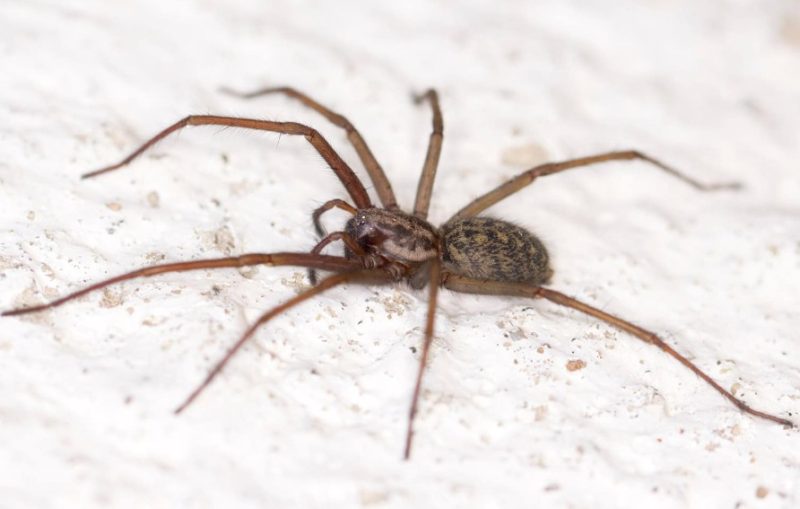
Appearance and Identification
Hobo Spiders are light to medium brown with a distinctive herringbone pattern on the top of the abdomen. The cephalothorax is slightly darker than the legs. They have eight eyes arranged in two rows and relatively long legs compared to their body size.
Size
Adult Hobos are 7–14 mm in body length, with a leg span of up to 50 mm. Males are slightly smaller and more slender than females. Their size and web pattern make them noticeable in basements or crawlspaces.
Behavior
Hobo Spiders construct funnel-shaped webs close to the ground or in human structures. They are fast runners and use the funnel to ambush prey. They tend to be shy and retreat when disturbed, biting only if pressed.
Bite and Venom
Bites can cause mild to moderate symptoms, including localized pain, redness, swelling, and occasionally lesions. Their venom may contain enzymes that cause tissue irritation. Severe systemic reactions are rare.
Habitat and Distribution
Originally from Europe, Hobo Spiders are now established in the Pacific Northwest and parts of Colorado. They inhabit basements, crawlspaces, sheds, and other sheltered structures. Outdoors, they prefer soil, rocks, and debris piles near human activity.
Yellow Sac Spider (Cheiracanthium spp.)
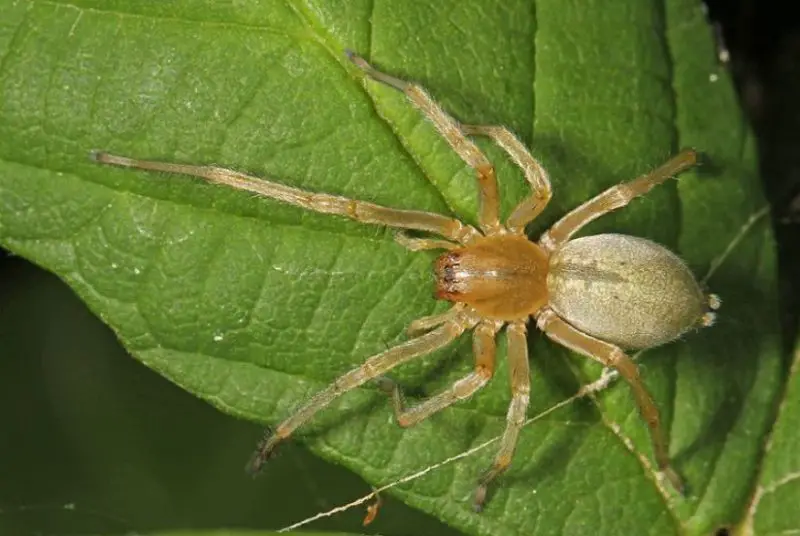
Appearance and Identification
Yellow Sac Spiders are pale yellow to light green, with darker markings on their legs. They have a relatively slender body and eight eyes arranged in two rows. Their small size and pale color can make them difficult to spot.
Size
Adults measure 5–10 mm in body length, with a leg span up to 25 mm. Females are slightly larger and bulkier than males. Their elongated legs and pale color allow them to blend into walls, ceilings, and plant surfaces.
Behavior
They are nocturnal hunters, leaving silk sacs during the day to rest in corners of rooms, under leaves, or in window wells. They actively hunt small insects rather than relying on webs to capture prey.
Bite and Venom
Bites may produce localized pain, redness, and swelling. Rarely, they may cause minor necrotic lesions. Their venom is primarily cytotoxic but generally poses little systemic risk to humans.
Habitat and Distribution
Yellow Sac Spiders are common throughout North America, including Colorado. They inhabit homes, gardens, and outdoor vegetation. They are most often seen indoors during fall when seeking shelter from cooler temperatures.
Western Tarantula (Aphonopelma spp.)
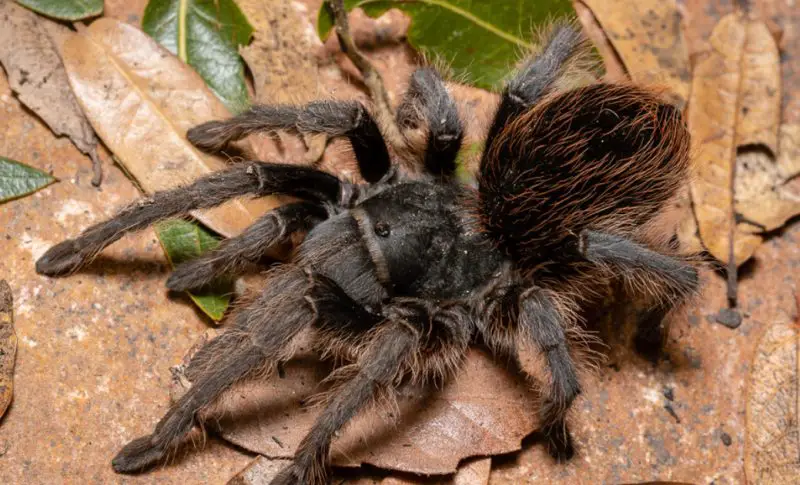
Appearance and Identification
Western Tarantulas are large, hairy spiders with a robust body. Color varies from dark brown to black, sometimes with reddish or orange hairs on the legs or abdomen. The fangs are prominent, and the carapace is broad and rounded.
Size
Adults can have a body length of 30–60 mm and a leg span up to 125 mm (5 inches). Males are smaller and more slender than females. Their size alone makes them one of the most noticeable spiders in the region.
Behavior
Tarantulas are primarily nocturnal and slow-moving. They live in burrows dug into the soil or found under rocks and logs. During mating season, males may wander in search of females. They are generally non-aggressive but can flick hairs as a defensive mechanism.
Bite and Venom
Bites are rare and usually result in mild pain, similar to a bee sting. Their venom is not considered medically significant to humans, but allergic reactions are possible. Defensive behaviors like hair flicking can irritate skin and eyes.
Habitat and Distribution
Western Tarantulas inhabit arid and semi-arid regions, particularly in southeastern Colorado. They prefer burrows in loose soil and are most active during late summer and fall. Populations are scattered but locally common in suitable habitats.
Best Time and Places to Observe Dangerous Spiders in Colorado
Western Black Widow
The best time to see Western Black Widows is late spring through early fall, when females are actively hunting and building webs. Look in dark, undisturbed areas such as woodpiles, garages, basements, sheds, and crawlspaces. They often hide under rocks, logs, or debris outdoors. Dusk and nighttime are ideal for spotting them, as they become more active.
Brown Recluse
Although rare in Colorado, Brown Recluses are most visible in warm months, typically May through September. They prefer secluded indoor areas like closets, attics, basements, or storage boxes. Outdoors, they may hide under rocks or debris. Nocturnal activity increases the chance of sightings.
Hobo Spider
Hobo Spiders are easiest to observe from late spring to early fall. They inhabit basements, crawlspaces, sheds, and outdoor debris piles near buildings. Funnel-shaped webs near the ground often indicate their presence. Evening and nighttime are ideal for spotting them as they hunt actively.
Yellow Sac Spider
Yellow Sac Spiders can be seen year-round but are most active from late summer to fall when seeking indoor shelter. Look along walls, ceilings, window sills, corners of rooms, under leaves, or in outdoor vegetation. Nocturnal hunting behavior makes evening a prime observation time.
Western Tarantula
Tarantulas are primarily seen during late summer and early fall, especially during mating season when males wander in search of females. Look for burrows in loose, sandy soil, under rocks, or near logs in southeastern Colorado. Evening and nighttime are the best times to observe them.
Safety Tips
Avoid Handling Spiders Directly
Most dangerous spiders in Colorado, including black widows and brown recluses, are non-aggressive and will only bite when provoked. Never try to pick up a spider with bare hands. Even small or hidden spiders can deliver painful bites, so always maintain a safe distance.
Wear Gloves When Reaching Into Storage, Woodpiles, or Debris
Many spiders prefer dark, undisturbed areas such as basements, garages, woodpiles, and garden debris. Wearing thick gloves can prevent accidental bites while handling boxes, firewood, or outdoor clutter. Protective clothing, including long sleeves and pants, adds an extra layer of safety.
Teach Children Not to Touch Spiders
Children are naturally curious and may try to handle or play with spiders. Educate them about the dangers of bites and emphasize that even small-looking spiders can be harmful. Supervision during outdoor play or when exploring storage areas can reduce risks significantly.
Steps to Take If Bitten
If bitten by a spider, immediately wash the area with soap and water and apply a cold compress to reduce swelling. Monitor for severe symptoms such as intense pain, muscle cramps, dizziness, or nausea. Seek prompt medical attention, especially if bitten by a black widow or brown recluse. If possible, safely capture or photograph the spider to aid identification by medical professionals.
How to Identify Spiders Safely
Learning to recognize key features of dangerous spiders—such as the black widow’s red hourglass or the brown recluse’s violin marking—can prevent accidental encounters. Use a flashlight or camera to observe spiders from a distance, and avoid disturbing their webs or hiding spots. Knowledge is the best defense against spider bites.
FAQs About Dangerous Spiders in Colorado
Are these spiders aggressive?
Most of these spiders are non-aggressive and will only bite if provoked or trapped. Western Black Widows and Brown Recluses are more dangerous because of their venom, but they rarely seek out humans.
What should I do if bitten?
Clean the bite area with soap and water, apply a cold compress, and seek medical attention immediately for severe symptoms. Capture the spider safely if possible for identification.
Can I find these spiders indoors?
Yes, Western Black Widows, Brown Recluses, Hobo Spiders, and Yellow Sac Spiders often hide in basements, attics, garages, and closets. Tarantulas are mostly outdoor dwellers, though males may wander indoors during mating season.
How can I prevent spider bites at home?
Wear gloves when handling stored items or gardening, seal cracks and openings in walls, and keep clutter to a minimum in dark areas. Regularly check sheds, basements, and storage boxes.
Are Tarantula bites dangerous to humans?
Generally, no. Western Tarantula bites cause mild pain similar to a bee sting. Their defensive hair flicking may irritate skin and eyes but is not venomous to humans.


